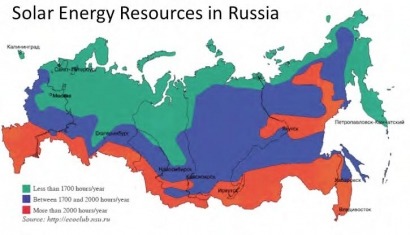Engineerblogger
Oct 07, 2011
Russia is the biggest country in the world and one of biggest suppliers of oil and gas has not yet seen a real need to develop a market for solar technologies.
This might change during the next few years - says Tomasz Slusarz, CEO of Solar PV Consulting - observing the policy and market situation on the global markets for the past 8 years and comparing it to the current situation in Russia, he is confident that cumulative solar installed capacity in Russia can reach above 1 or even 2 GW by 2020. He is even ready to bet on it. Here are his three arguments to back the claim.
Argument 1: Growing energy demand
In 2009, the Russian Energy Agency was forecasting that 51.7 GW of capacity would be decommissioned by 2020, requiring more than 150 GW of new capacity to meet consumption growth during the current decade.
I also notice a growing understanding from Russian policy makers and the private sector that increased use of renewable energy technologies can help meet the growing demand.
The Energy Strategy of Russia has set a target of 4.5% for the installed renewable electricity generation by 2020 (including small hydro up to 25 MW), which means a requirement of 22 GW for the new installed capacity.
As there are no sectorial targets within the 4.5% target, theoretically, quasi whole renewable energy capacity can be built from small hydro, wind, biomass or geothermic sources. However, in my opinion, solar PV with its more and more competitive prices can become a quite an important piece of the 22 GW cake.
Increasingly competitive prices of solar PV generation will be confronted with rapidly growing electricity prices in the country. According to the 2010 Budget of the Russian Federation, in 2020 the average electricity tariffs for all users will reach a level of 10.5cents/kWh and residential tariffs 15.3cents/kWh, compared to today's 7cents/kWh.
Argument 2: Huge investments in production capacities
Russian solar industry and RUSNANO, a state-owned fund, have invested billions of dollars in new manufacturing facilities such as Hevel Solar (thin-film PV), and Nitol (large-scale polysilicon and monosilane manufacturing).
When looking at the increasingly competitive global solar markets, they realize the urgent need to establish a sustainable domestic market in order to help the Russian industry grow and be able to compete on export markets.
Few weeks ago we heard that Russia's North Caucasus region is about to set up its own Silicon Valley with a joint venture between the regional government and private businesses. The cost of the project would be around 1 billion USD with pre-estimated production volume of 12 billion USD per year, and 2 to 7 years of return on investments.
Polycrystalline silicon production would be located in Stavropol region, with monocrystalline silicon production set up in Kabardino-Balkaria. The final production of photovoltaic cells and solar modules would be located in Karachay-Cherkessia and Dagestan respectively.
I am quite sure that if the project is successful, a lot of modules will be installed not only in the region but also all over the country.
Argument 3: Russia - sunny country!
The technical potential of solar energy was estimated as 1.870 TWh, with an economic potential of around 101 GWh per year in the national report titled "Role of renewable energy sources in energy strategy of Russia".
The southern parts of Russia, especially the North Caucasus, have the greatest potential for solar energy. The Krasnodar Region and most parts of Siberia have insolation levels comparable to the south of France and central Italy while the Zabaikalsky Region gets more solar energy than Spain.
Argument 4: Big giants start to understand that solar PV can be a good business
It is worth to mention that today not only Renova group of companies, one of the largest diversified business groups in Russia, understand that solar energy can be a profitable investment.
Renova is a major shareholder of Oerlikon and controlling shareholder of Avelar Energy Group as well as a shareholder of previously mentioned Hevel Solar. It has also recently established NAVI Capital Management, a fund that is going to invest 200 million dollars in clean-tech innovation with an important focus on solar PV.
Lukoil, a major Russian oil company, in partnership with the government of Uzbekistan and the Asian Development Bank, is planning to construct Uzbekistan's largest solar plant, which will have an initial capacity of 100 MW, to expand eventually to 1 GW. Earlier this year Lukoil started to build its first 4 million dollar solar plant in Bulgaria.
These examples show that a growing number of Russian giant companies, with available financial resources, feel that investing in solar energy can be a good business strategy.
Moreover, I have heard from many companies exhibiting at 26EUPVSEC that their booths were visited by representatives from some of the biggest energy companies in Russia, which were potentially interested in investing in solar parks in Italy, Greece or Bulgaria. I am quite sure that at the end of the day these big companies will strongly support the development of a domestic solar market.
Source: Solardaily.com
Additional Information:

0 comments:
Post a Comment